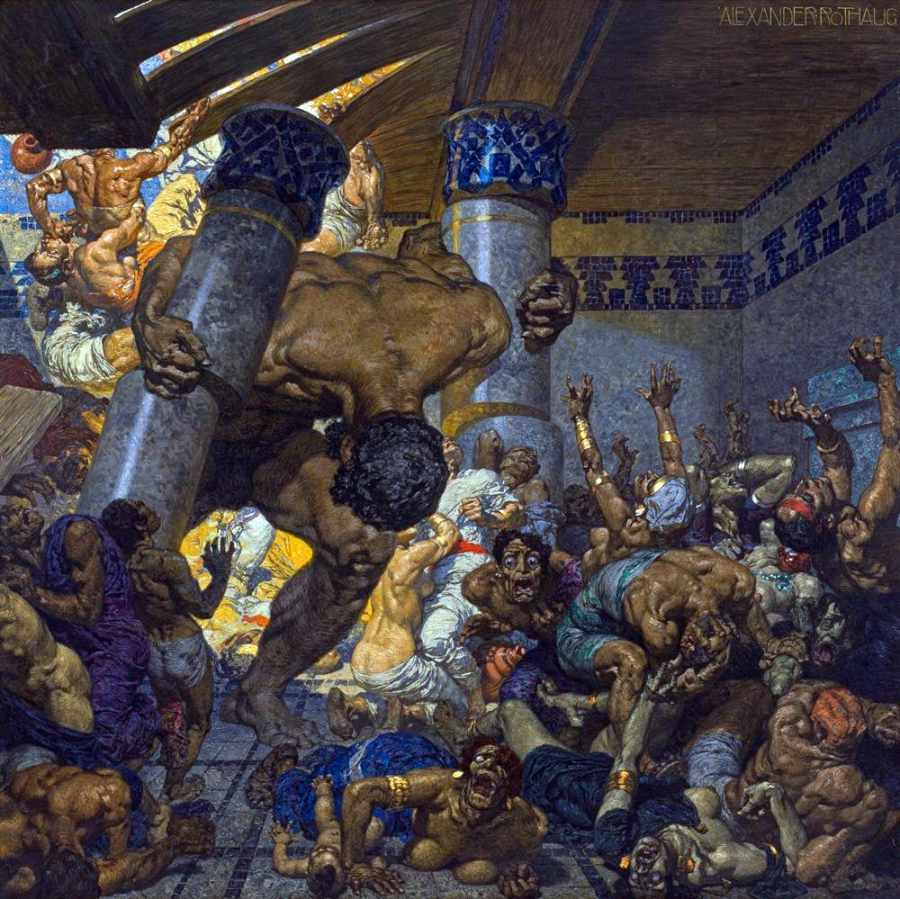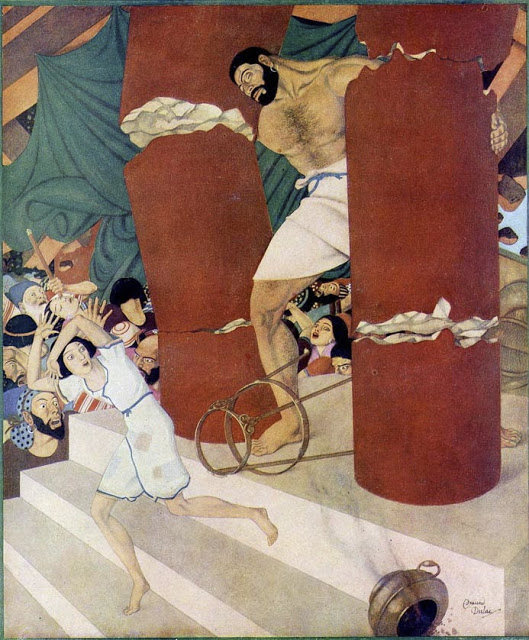Samson (“man of the sun”) was the last of the judges of the ancient Israelites mentioned in the Book of Judges (chapters 13 to 16) and one of the last leaders who “judged” Israel before the institution of the monarchy. He is sometimes considered as an Israelite version of the popular Near Eastern folk hero also embodied by the Sumerian Enkidu and the Greek Heracles. The biblical account states that Samson was a Nazirite, and that he was given immense strength to aid him against his enemies and allow him to perform superhuman feats, including slaying a lion with his bare hands and massacring an entire army of Philistines using only the jawbone of a donkey. However, if Samson’s long hair were cut, then his Nazirite vow would be violated and he would lose his strength. Samson is betrayed by his lover Delilah, who, sent by the Philistines officials to entice him, orders a servant to cut his hair while he is sleeping and turns him over to his Philistine enemies, who gouge out his eyes and force him to grind grain in a mill at Gaza. While there, his hair begins to grow again. When the Philistines take Samson into their temple of Dagon, Samson asks to rest against one of the support pillars. After being granted permission, he prays to God and miraculously recovers his strength, allowing him to bring down the columns, collapsing the temple and killing himself as well as all of the Philistines. In some Jewish traditions, Samson is believed to have been buried in Zorah in Israel overlooking the Sorek valley. Samson has been the subject of rabbinic, Christian and Islamic commentary, with some Christians viewing him as a type of Jesus, based on similarities between their lives.
| Alias Samson |
| Real Names/Alt Names Samson |
| Characteristics Hero, Biblical Figures, Historical Figures, Literary Characters, Super Strength, Classical Antiquity, Middle Eastern |
| Creators/Key Contributors ○ |
| First Appearance Hebrew Bible (Tanakh) |
| First Publisher ○ |
| Appearance List Literature: Hebrew Bible (Tanakh), Quran, The King James Version of the Bible, Geoffrey Chaucer’s “The Canterbury Tales” (14th century), Antonio Enríquez Gómez’ Sansón Nazareno: Poema heróico (1656), John Milton’s Samson Agonistes (1671), Moshe Chaim Luzzatto’s Samson (1724), Vladimir Jabotinsky’s Samson (1926). Film: Cecil B. deMille’s Samson and Delilah (1949), Aurat (1953), Samson (Sansone, 1961), Samson vs. The Pirates (a.k.a. Samson and the Sea Beast, 1963), Samson Challenges Hercules (a.k.a. Hercules, Samson and Ulysses, 1963), Samson vs. the Black Pirate (a.k.a. Hercules and the Black Pirate, 1963), Samson and His Mighty Challenge (1965), Samson (Indian action-adventure film, 1964). Comics: Kid Eternity #25, 33, 53, Spectacular Features Magazine #11. |
| Sample Read The King James Version of the Bible [PG] |
| Description Samson (“man of the sun”) was the last of the judges of the ancient Israelites mentioned in the Book of Judges (chapters 13 to 16) and one of the last leaders who “judged” Israel before the institution of the monarchy. He is sometimes considered as an Israelite version of the popular Near Eastern folk hero also embodied by the Sumerian Enkidu and the Greek Heracles. The biblical account states that Samson was a Nazirite, and that he was given immense strength to aid him against his enemies and allow him to perform superhuman feats, including slaying a lion with his bare hands and massacring an entire army of Philistines using only the jawbone of a donkey. However, if Samson’s long hair were cut, then his Nazirite vow would be violated and he would lose his strength. Samson is betrayed by his lover Delilah, who, sent by the Philistines officials to entice him, orders a servant to cut his hair while he is sleeping and turns him over to his Philistine enemies, who gouge out his eyes and force him to grind grain in a mill at Gaza. While there, his hair begins to grow again. When the Philistines take Samson into their temple of Dagon, Samson asks to rest against one of the support pillars. After being granted permission, he prays to God and miraculously recovers his strength, allowing him to bring down the columns, collapsing the temple and killing himself as well as all of the Philistines. In some Jewish traditions, Samson is believed to have been buried in Zorah in Israel overlooking the Sorek valley. Samson has been the subject of rabbinic, Christian and Islamic commentary, with some Christians viewing him as a type of Jesus, based on similarities between their lives. |
| Source Samson – Wikipedia |


